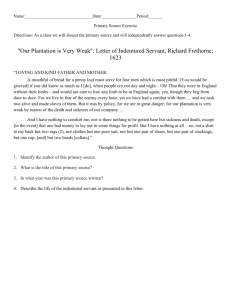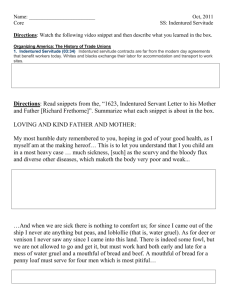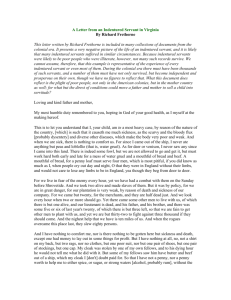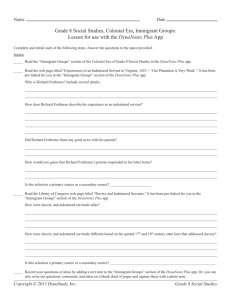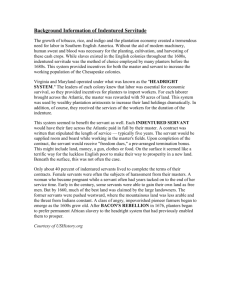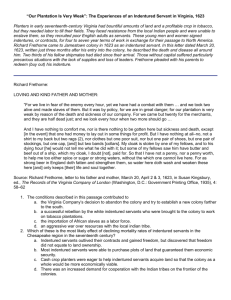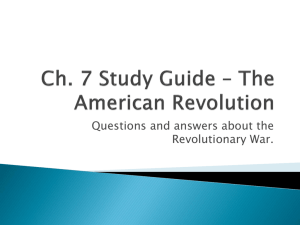Indentured Servitude
advertisement
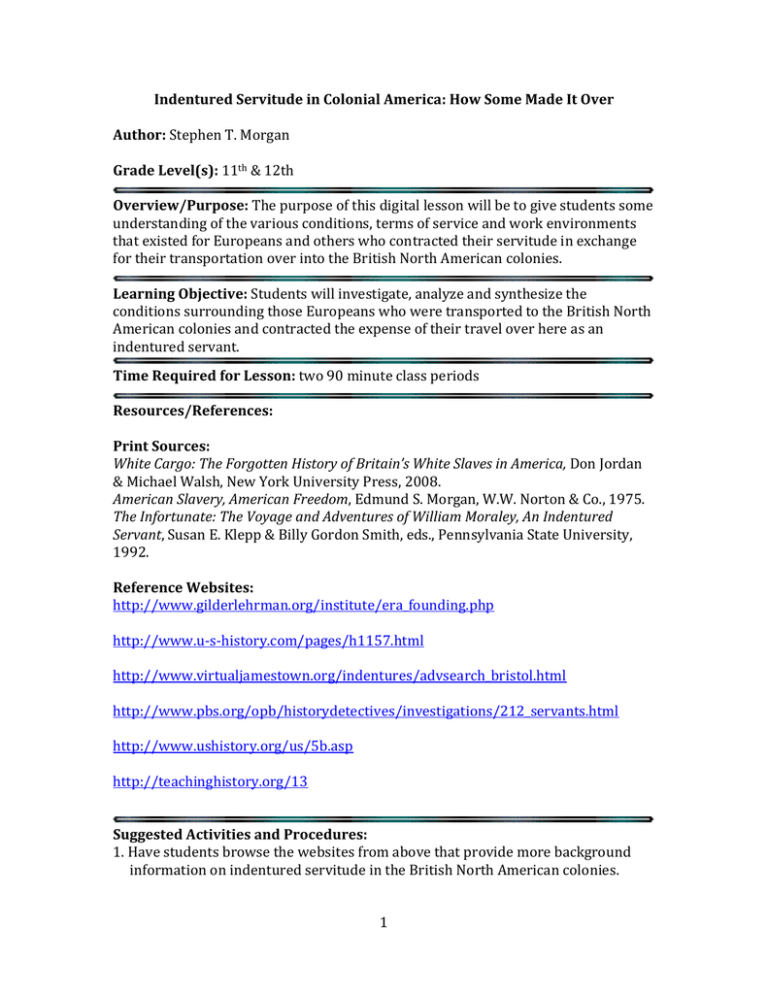
Indentured Servitude in Colonial America: How Some Made It Over Author: Stephen T. Morgan Grade Level(s): 11th & 12th Overview/Purpose: The purpose of this digital lesson will be to give students some understanding of the various conditions, terms of service and work environments that existed for Europeans and others who contracted their servitude in exchange for their transportation over into the British North American colonies. Learning Objective: Students will investigate, analyze and synthesize the conditions surrounding those Europeans who were transported to the British North American colonies and contracted the expense of their travel over here as an indentured servant. Time Required for Lesson: two 90 minute class periods Resources/References: Print Sources: White Cargo: The Forgotten History of Britain’s White Slaves in America, Don Jordan & Michael Walsh, New York University Press, 2008. American Slavery, American Freedom, Edmund S. Morgan, W.W. Norton & Co., 1975. The Infortunate: The Voyage and Adventures of William Moraley, An Indentured Servant, Susan E. Klepp & Billy Gordon Smith, eds., Pennsylvania State University, 1992. Reference Websites: http://www.gilderlehrman.org/institute/era_founding.php http://www.u-s-history.com/pages/h1157.html http://www.virtualjamestown.org/indentures/advsearch_bristol.html http://www.pbs.org/opb/historydetectives/investigations/212_servants.html http://www.ushistory.org/us/5b.asp http://teachinghistory.org/13 Suggested Activities and Procedures: 1. Have students browse the websites from above that provide more background information on indentured servitude in the British North American colonies. 1 2. Provide the students with guided questions in a worksheet format so the students have to summarize and write down the main points of the primary source documents. 3. Then have students read the primary source documents from the lesson websites below either alone or as part of a group. 4. Discuss with students what they have read by answering the guiding questions prepared by the teacher or by just having a general discussion. Teacher Notes and Suggestions: Make printed copies of the primary source documents in case the students do not have access to the Internet. Provide the following guiding questions on a worksheet that get the students to write down the main points of the primary source documents in case the students feel they have nothing to share. Student Materials/Instructions: Students will need their laptops and access to the Internet. The teacher will provide guided questions in a worksheet format. Lesson Websites: http://www.let.rug.nl/usa/D/1601-1650/mittelberger/servan.htm http://www.pbs.org/opb/historydetectives/investigations/212_indenturedfeature. html http://gilderlehrman.pastperfectonline.com/33267cgi/mweb.exe?request=record;id=5EC23DF9-2014-4968-A605297240891804;type=301 http://www.virtualjamestown.org/wbind1.html http://etext.lib.virginia.edu/etcbin/jamestown-browse?id=J1046 http://chnm.gmu.edu/exploring/pre_18thcentury/indenturedservitude/pop_fretho rne.html http://chnm.gmu.edu/exploring/pre_18thcentury/indenturedservitude/pop_confe ssion.html 2 Extending the Lesson: Students could write a summary essay over the primary source documents with a guided question that the teacher provides. This lesson plan could also be extended by reading primary sources of the groups that settled in the Massachusetts Bay Colony and compare it to the types of groups that settled in the Chesapeake region. Assessment(s): Students will complete a worksheet with guided questions about the primary source document or will write an essay using a guided question provided by the teacher. (See worksheet below.) Content Standards: Using the McRel standards at http://www.mcrel.org/standardsbenchmarks/standards: U.S. history: Standard 3, Level 4, Statement 1 U.S. history: Standard 4, Level 4, Statements 1, 2, 4, 5, & 6 U.S. history: Standard 5, Level 4, Statements 1, 2, 3, & 4 Historical Understanding: Standard 2, Level 4, Benchmark 2.1, 2.2, 2.3, & 2.4 Historical Understanding: Standard 2, Level 4, Benchmark 3.1 Historical Understanding: Standard 2, Level 4, Benchmark 4.1 Historical Understanding: Standard 2, Level 4, Benchmark 5.1 & 5.2 Historical Understanding: Standard 2, Level 4, Benchmark 6.1 & 6.2 Historical Understanding: Standard 2, Level 4, Benchmark 9.1 Historical Understanding: Standard 2, Level 4, Benchmark 10.1 & 10.2 Historical Understanding: Standard 2, Level 4, Benchmark 11.1 & 11.2 Historical Understanding: Standard 2, Level 4, Benchmark 12.1 & 12.2 Historical Understanding: Standard 2, Level 4, Benchmark 13.1 & 13.2 South Dakota Reading Standards at http://doe.sd.gov/contentstandards/documents/Completed%20Reading.pdf 11.R.4.1 11.R.5.1 Miscellaneous Information: 3 U.S. history Guided Questions for: Primary Source Documents on Indentured Servitude Name ___________________ Date _____________ Background Questions: 1. From what county in Europe did most of indentured servants come? 2. What gender were most of the indentured servants that came over to America? 3. What was the average length of a term of service? 4. Were African Americans ever used as indentured servants? When did the practice of contracting African Americans end? 5. What were conditions like for those who did contract as a servant? 6. In what ways was being an indentured servant like being a slave? 7. What were “freedom dues”? 8. For what reasons did servants relinquished their “freedom dues”? 9. For what reasons did people re-contract their service as an indentured servant? Gottlieb Mittelberger: On the Misfortune of Indentured Servants, 1754 1. From what country are most of the people on board Mittelberger’s ship? 2. Approximately how many people does Mittelberger estimate are on this ship? 3. To what country does this ship have to go in order to pay the custom duty for those on board? 4. Approximately how many days will the ship have to be anchored there? 4 5. Approximately how many weeks will it take before this ship arrives in Philadelphia? 6. What kinds of sickness occur on voyages such as this one? 7. What causes these sicknesses according to Mittelberger? 8. According to Mittelberger what occurs that make the people “cry and pray most piteously”? 9. How did Mittelberger help the ships’ occupants to pass the time? 10. Why did Mittelberger act as a minister on board the ship? 11. Who are the “soul-traffickers”? 12. How did children fare on this journey? 13. Describe the food and water on board this particular ship? 14. How come most of the people on board the ship were not allowed to disembark from the vessel once they arrived in Philadelphia? 15. Which of the passengers fared the worse because of this sequestering? 16. What kind of contract are teenage children obliged to offer? 5 17. How did families fare during these offerings of contract? 18. What was unusual about passage fee for family members who died enroute? 19. Describe what happens when a contracted servant wants to marry? 20. Describe why it was hard for contracted servants to run away? What was the punishment for doing so? Indenture apprenticing Javin Toby to John Steadman: 1. In what colony does this transaction take place? 2. For how long did Hannah Toby contract her son’s services? 3. Describe the kinds of rules Javin Toby was expected to obey? 4. When will his term of service be up? 5. What will he receive as his “freedom dues”? 6. Infer. Why might Javin’s mother be seeking a contract of service for her son? Indenture Contract of William Buckland: 1. To whom did William Buckland contract his service? 2. For how long did Buckland contract his service? 6 3. How is this contract a bit different than the other contracts in this grouping? 4. What did Buckland expect to receive at the end of his term of service? First Hand Accounts of Virginia, 1575-1705: 1. When was this contract made? 2. Who was the king of England at the time? 3. What was the name of the man that contracted his service? 4. To whom did he contract his service to? 5. For how long was the term of service in this contract? 6. What could the servant in this contract expect for his “freedom dues”? John Frethorne's Letter to His Parents, 1623: 1. What are the conditions of the plantation and the other servants where Frethorne is stationed? 2. This letter was written in 1623. Who is the enemy that he refers to in the letter? 3. How far is the nearest plantation to the one Frethorne is stationed at? 4. What does Frethorne suspect happened to his cloak? 5. How come Frethorne is not as strong as he was in England? 6. Mr. Jackson gave Frethorne some “poor jacks.” What are “jacks”? 7 7. In this letter, what does Frethorne plead his mother and father to do? 8. What is Frethorne’s alternative if they can not meet his first priority? 9. What does Frethorne promise his father he will do in return for food sent to him? 10. In whose name does Frethorne tell his father to address anything sent over here to America? Indentured Servant's Confession, 1684: 1. What is the name of the person who made this confession? 2. Whom is the confession about? 3. What did this confessor say he saw John Fisher do? 4. In the first misdemeanor, what did John Fisher do that was so wrong? 5. In the second misdemeanor, what did John Fisher persuade the others to do? 6. What was John Fisher’s crime in the paragraph marked third misdemeanor? 7. What wrongs do the rest of the misdemeanor’s pertain to? 8. What can we deduce about how these indentured servants were fed? 9. In what year was this confession made? 10. What can we deduce about the conditions of indentured servants during the 17th century? 8
